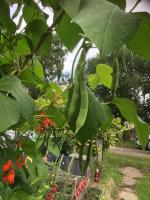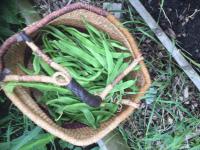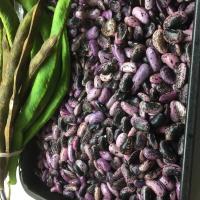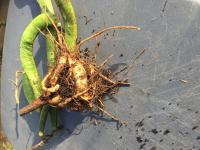Recent articles
© Bylawmen's Field Allotments 2010 - 2025
| Runner BeansA versatile and worthwhile crop to grow producing pods in abundance, the surplus which can be frozen throughout the summer. In late summer as the pods become fibrous and stringy the beans can then be left to form seeds to be eaten fresh and others for harvesting usually around mid October when the pods start to turn brown. These are dried to be used during the winter, after being soaked over night to add to soups and stews. With,of course beans to be saved for sowing the following season. A great deal is written about preparing the ground for a bumper crop, my method, because my soil is fertile, is to mulch the proposed plot with either two inches of well rotted horse manure or compost in late autumn and leave the worms to work it into the soil. Nonetheless I have seen some of my fellow plot holders obtaining reasonable crops without any elaborate preparation.
SOWINGThe aim is for the first shoots to be emerging in late May/early June when the risk of frost has passed. Therefore sowing in open ground should be around mid May. Whilst this should avoid the risk of a late frost decimating the emerging shoots it wont avoid the legions of slugs and snails feasting on the rising shoots with the sometimes problem of the swollen seeds being dug up and eaten by either mice or rats.My approach to avoiding frost,slug,snail, and rodent onslaught as well as getting an early start is to sow indoors in late April and growing on in either a greenhouse or cold frame. The aim being for sturdy plants that have been hardened off to be planted out at the end of May, early June First I chit the seed by placing them in a polythene bag that contains damp potting compost and leaving them on the kitchen unit to sprout. The seeds should be showing a 'tail' within a week; keep the compost moist but not soaking wet. I find one litre drinks carton,with the top cut off, well washed and a few holes punched in the bottom are ideal to plant into. The ‘tail’ is the start of the roots so should be pointing downwards in the pot. They will only be in these containers about four weeks so, being a frugal allotment gardener, I use the contents of the containers which my tomato and summer bedding have grown in after adding a light dusting of lime. Suitably hardened off I plant out the last week in either the last week in May or first week in June when the risk of a frost has passed. PLANTING OUT AND GROWING ONI plant out at 8 inches[20cms] in rows two feet [60cms] apart using eight foot [2.4cms] bamboo canes.A two inch [8cms] mulch of either well rotted manure or garden compost is sufficient to sustain the plants without having to resort to the use of fertiliser. It helps in the early days to spray the emerging flowers to assist with them setting pods. During dry spells it is beneficial to water copiously other than that they need little attention apart from taking out the growing tip once it has reached the top of the frame. HARVESTINGOnce the plants are established they begin to produce pods in abundance which I harvest every two/three days. The surplus being gifted to family and friends with some being frozen for winter use. I use a bean shredder placing the pods on a tray to freeze [no need to blanch them] just bag them up when frozen.Towards middle/late September the pods become stringy and fibrous so I leave them to swell and harvest the beans to eat in a way similar to how broad beans are cooked and eaten. I leave the beans to continue to swell and eventually drying out towards the end of October. These dried beans are then either saved for the following years seed or soaked overnight to cook the following day. RUNNER BEAN ROOTSThere is another way of ensuring plants for the following year other than saving seed. Runner beans are actually a perennial although we grow them as annuals but it is possible to lift the roots, which are similar in appearance to small, thin dahlia tubers. You can start them off the following year in pots in late April, hardening them off and planting out when the danger of frosts have past in late May.Runner Beans A versatile and worthwhile crop to grow producing pods in abundance, the surplus which can be frozen throughout the summer. In late summer as the pods become fibrous and stringy the beans can then be left to form seeds to be eaten fresh and others for harvesting usually around mid October when the pods start to turn brown. These are dried to be used during the winter, after being soaked over night to add to soups and stews. With,of course beans to be saved for sowing the following season. |








